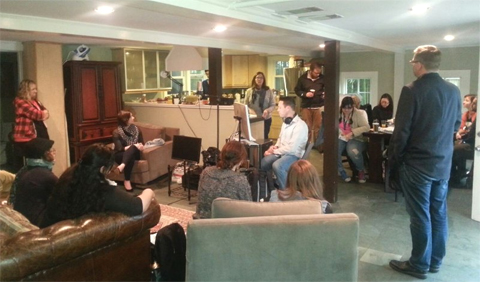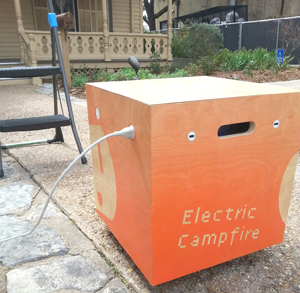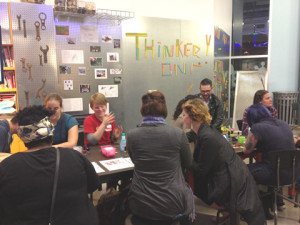
Librarians from all over the country have landed in Austin, Texas, for SXSW Interactive, a five-day conference of tech professionals and venture capitalists, startups and entrepreneurs, gamers and makers, and everything in between. For the past few years, a group of library, archives, and museum professionals have coordinated to present sessions, advocate for libraries, and learn about trends that are happening in technology-related fields. The group goes by #sxswLAM (libraries, archives, museums) and you can learn more about all of their own and related activities on their website. I’ll be posting a few accounts from my own perspective as a librarian about what this bohemoth of a conference is like.
My day started on Friday at the Library #IDEAdrop house, a project of Bonnie and Sandy Tijerina of ER&L (Electronic Resources and Libraries). They have rented a house with the goal of bringing some of the conversations happening at SXSW to a library-themed living-room space, where they livestream the interactions to be shared with the greater library community and anyone else who is interested. The house has also become the gathering space for the #sxswLAM crew and EveryLibrary is sponsoring morning meetings for folks to gather, charge up for the day, share things they’ve learned, and coordinate where we should be throughout the day. It’s been a wonderful convening space and a place for me to connect with the passionate professionals that are involved in the greater library world.
 On Friday afternoon, I headed over to the O Henry House to check out the Labrary, a pop-up library space. There, I met Jeff Goldenson and Jessica Yurkofsky who work with the Library Test Kitchen, a design class at Harvard. The class creates library machines and we got to sample a few of them, including Book Face and the Electric Campfire. The first is an interactive exhibit that allows you to take a picture in a murder mystery photo booth. The Electric Campfire is a mobile charging station that runs on car batteries so it can roll into any location. Electric Campfire encourage connectivity, not only with your electronics, but also with those around you who are also charging. It’s always great to see technologies and libraries converge to create something new and unexpected.
On Friday afternoon, I headed over to the O Henry House to check out the Labrary, a pop-up library space. There, I met Jeff Goldenson and Jessica Yurkofsky who work with the Library Test Kitchen, a design class at Harvard. The class creates library machines and we got to sample a few of them, including Book Face and the Electric Campfire. The first is an interactive exhibit that allows you to take a picture in a murder mystery photo booth. The Electric Campfire is a mobile charging station that runs on car batteries so it can roll into any location. Electric Campfire encourage connectivity, not only with your electronics, but also with those around you who are also charging. It’s always great to see technologies and libraries converge to create something new and unexpected.
The last thing I’d like to share is about a session I attended called “The Ten Best Startups in Austin.” This session featured startups doing pitches for their projects. My librarian brain started to think about how libraries could use certain technology and ideas I heard about to deliver services to our community. There were a few in particular that I think had definite library connections: Famigo and Weeva. The first is an app that creates a safe, fun, and educational learning environment for kids on mobile devices and the second is an online platform for a group of people to share stories, pictures, and soon, oral histories, and to aggregate this information in one place. One of the major advocacy messages that we are trying to talk to tech professionals about is the ways in which businesses can leverage library resources at every stage to build better products and save money. What if Famigo and Weeva worked with libraries to make their products better? Wouldn’t the work that we do in determining the legitimacy of kids’ online learning products and helping folks to record their oral histories make wonderful expertise for these startups? (To learn more about libraries and startups, read the press release from EveryLibrary, which is doing great work to plug libraries into the SXSW Interactive world.)
MARY ABLER is a public librarian currently employed as an Innovation Leadership Program Resident, a joint project of the Los Angeles Public Library and the Library Foundation of Los Angeles.


